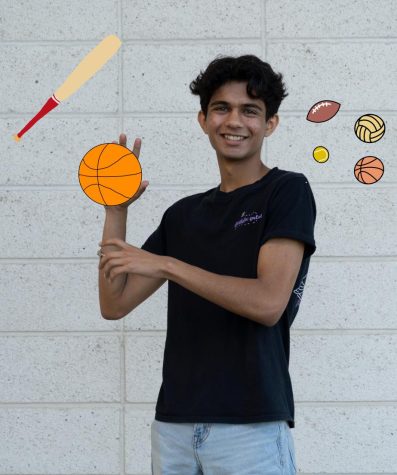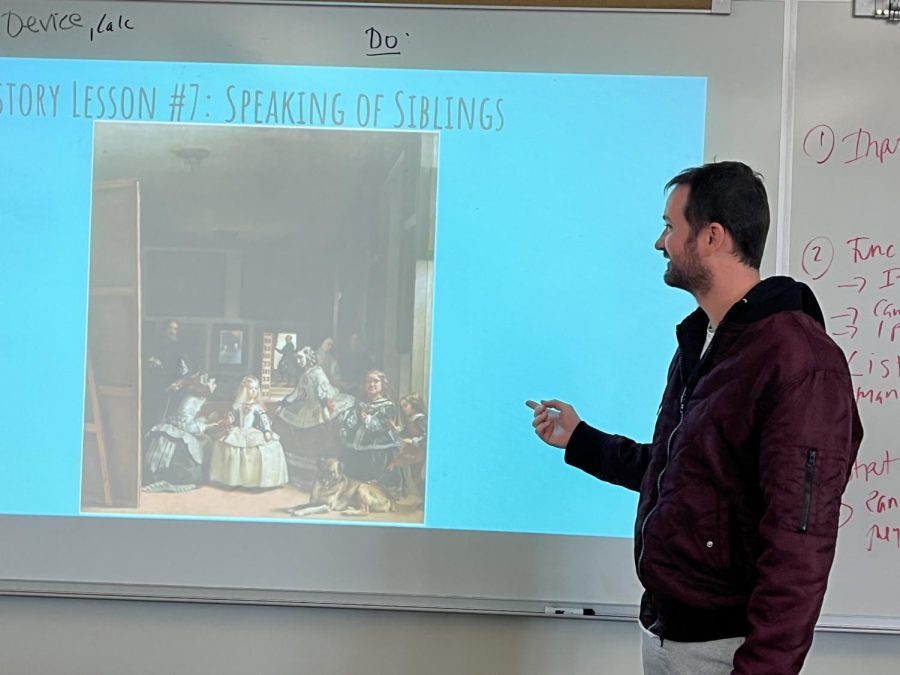Data meets Da Vinci: A Math Teacher’s Journey into the World of Art History
Math teacher Eric Graham presents “Las Meninas” by Diego Velázquez to his class. Out of all the artwork Graham has seen over the years, he says that “Las Meninas” is his favorite piece because of the story and intricate details that the painting holds.
The soft glow of natural light pours into the eerie chamber, as the deep, somber shadows begin their retreat to the outskirts of the room. In the center stands a small girl, lost in her own world, surrounded by an entourage of maids and helpers. In the background of the chamber stands a mirror, reflecting the ghostly image of a king and queen while an unknown man makes his silent escape in the back of the room.
For math teacher Eric Graham, such a scene from the painting “Las Meninas” by Diego Velázquez is much more than a fleeting moment intricately captured on a canvas. It is a story waiting to be told—a puzzle to be solved.
Or, perhaps more fittingly, a variable “x” yearning to be found.
Graham first developed his passion for art history in high school while taking an AP Art History class. Under the guidance of his teacher Mr. Harold, Graham became fascinated with art and the stories that it has the potential to tell.
“He was so good at telling stories, and I think that’s probably why I’m connected to art that has a story behind it,” Graham said. “He’s a lot of the inspiration that kind of got me kind of piqued me into it.”
In Graham’s classroom between math lectures, he incorporates small breaks to share various pieces of art and the stories behind them with his students. Sharing the stories and history behind art serves as a way to carry on the legacy of Harold, as well as inspire his students to take art and its meaning more seriously, according to Graham.
“I just think art history is a reflection of everything that humanity has been through throughout history,” senior Rhea Sheth said. “The saying is that ‘art reflects life.’ So when events in history happen, you can see it reflected through art, and you can see how people’s view of the world is changing through different expressions in art.”
Graham’s love for art is not just limited to a collection of vibrant colors on a canvas. Rather, Graham sees art as a captured moment that invokes some form of human emotion, which can be displayed through paintings, comedy and even TikTok videos.
In today’s fast-paced digital world with information and opinions so widespread, Graham feels that it becomes harder for students to create connections and opinions that are truly unique to themselves. Graham said he hopes that sharing his love for art can inspire his students to think creatively and, just maybe, visit an art museum.
“In the end, art is about what you interpret it to be and what you feel from it,” Graham said. “An important part of having more kindness and happiness in the world is if we can have a shared experience, even if that may be a different perspective from each other. We kind of feel the same thing, but maybe we have a different experience to why we got there, and I think it can just bring people closer together.”
Your donation will support the student journalists of Portola High School. Your contribution will allow us to purchase equipment and cover our annual website hosting costs.

Arnav Chandan is the Sports Editor and Co-Business Manager for his second and final year on the Portola Pilot. Outside of spending hours upon hours in...




